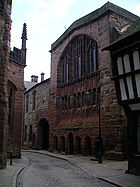
St Mary's Guildhall
Encyclopedia

Guildhall
A guildhall, or guild hall, is a building historically used by guilds for meetings and other purposes. It is also the official or colloquial name for many of these specific buildings, now often used as town halls or museums....
built in Coventry
Coventry
Coventry is a city and metropolitan borough in the county of West Midlands in England. Coventry is the 9th largest city in England and the 11th largest in the United Kingdom. It is also the second largest city in the English Midlands, after Birmingham, with a population of 300,848, although...
, Warwickshire
Warwickshire
Warwickshire is a landlocked non-metropolitan county in the West Midlands region of England. The county town is Warwick, although the largest town is Nuneaton. The county is famous for being the birthplace of William Shakespeare...
, England and extended 1340–1460, The Building has a vaulted undercroft
Undercroft
An undercroft is traditionally a cellar or storage room, often brick-lined and vaulted, and used for storage in buildings since medieval times. In modern usage, an undercroft is generally a ground area which is relatively open to the sides, but covered by the building above.- History :While some...
which is currently a restaurant.
The guildhall served as the combined headquarters of the united guilds of the Holy Trinity, St. Mary, St. John the Baptist and St. Katherine. Following the suppression of guilds in 1547, for a time it served as the city's armoury and (until 1822) its treasury, as well as the headquarters for administration for the city council until a new Council House was officially opened in 1920.
In November 1569, following the Catholic Rising of the North
Rising of the North
The Rising of the North of 1569, also called the Revolt of the Northern Earls or Northern Rebellion, was an unsuccessful attempt by Catholic nobles from Northern England to depose Queen Elizabeth I of England and replace her with Mary, Queen of Scots.-Background:When Elizabeth I succeeded her...
, Mary Queen of Scots was rushed south from Tutbury Castle
Tutbury Castle
Tutbury Castle is a largely ruinous medieval castle at Tutbury, Staffordshire, England, in the ownership of the Duchy of Lancaster. It is a Grade I listed building...
to Coventry. Elizabeth I sent a letter, instructing the people of Coventry to look after Mary. She suggested that Mary be held somewhere secure such as Coventry Castle
Coventry Castle
Coventry Castle was a motte and bailey castle in the city of Coventry, England .It was built in the 11th century by Ranulf Meschines, Earl of Chester, probably out of wood initially...
. However, by that time it was too decayed and Mary was instead first held at the Bull Inn, Smithford Street before being moved to the Mayoress's Parlour in St. Mary's. Following the defeat of the rebels, Mary was once more sent north to Chatsworth
Chatsworth
-Places:Australia* Chatsworth, Queensland* Electoral district of Chatsworth, Queensland, AustraliaCanada* Chatsworth, Ontario, a township* Chatsworth, Ontario , located within above townshipSouth Africa* Chatsworth, Durban* Chatsworth, Western Cape...
in May 1570.
George Eld
George Eld
George Eld was a London printer of the Jacobean era, who produced important works of English Renaissance drama and literature, including key texts by William Shakespeare, Ben Jonson, Christopher Marlowe, and Thomas Middleton....
, mayor of Coventry (1834–5) was an antiquarian who encouraged appreciation of Coventry's ancient buildings. He initiated the restoration of the fourteenth-century interior of the mayoress's parlour.
In 1861, the artist David Gee painted The Godiva Procession
Godiva Procession
The Godiva Procession is an annual procession in the city of Coventry, England, which re-enacts the story of Lady Godiva. They have been held in Coventry since the 17th century.-History:...
Leaving St. Mary's Hall, the picture is now on display in the Herbert Art Gallery, Coventry.
Restoration work by the council received the approval of the committe of the Coventry City Guild in 1930. Improvements had included the repair of the door at the north entrance to the crypt and providing glass & grilles in the windows of the fore crypt. Outside the crumbling exterior stonework was stabilized.

